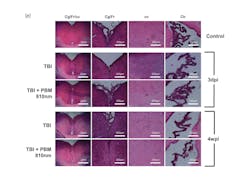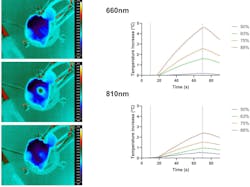Light therapy approach better treats brain injuries
Researchers at the University of Birmingham (U.K.) discovered an approach for treating mild traumatic brain injuries using photobiomodulation (PBM; see video)—also known as low-level laser therapy, which can increase cellular metabolism and stimulate cells and tissues.
The team’s now-patented approach relies on red and near-infrared (near-IR) light in the 600- to 1000-nm wavelength range, where it can be absorbed by cytochrome-c oxidase, the main light-sensitive molecule in mitochondria. This aids cellular respiration, the formation of adenosine triphosphate (ATP; an energy source essential for healthy brain function) molecules, modulation of oxidative stress, and reduced free radical production. It also triggers cell signaling and gene transcription.
“All of this leads to the positive effects of photobiomodulation,” says Zubair Ahmed, a professor of neuroscience and the Neuroscience and Ophthalmology section lead.
In a series of tests on rodent subjects, the research team shone near-IR light at 660 nm and 810 nm into injured tissue for three days post-injury. Over the course of about a month, they found the PBM approach ultimately boosted numerous functions including cellular respiration and ATP formation. It also decreased cell death, neuronal damage, and inflammation, and stimulated regeneration of brain tissue.
PBM therapy reduced the activation of astrocytes and microglial cells, which contribute to inflammation in the brain after head trauma. The researchers also saw significant improvements in the subjects’ performance of functional tests relating to balance and cognitive functions. And red light therapy—at 810 nm specifically—even accelerated recovery.
Meeting therapy needs
There is currently no therapy for central nervous system axon (nerve fiber) regeneration and functional recovery. After a traumatic brain or spinal cord injury, nothing can be done to cure it or the progressive disabilities it causes, including paralysis, cognitive problems, balance, loss of basic bodily function, etc.
To promote axon regeneration and, in turn, functional recovery, a multitude of pathways need to be modulated at the same time. “PBM appears to have the potential to activate multiple healing pathways in a single therapy,” Ahmed says, “so it can be used to mitigate the effects of brain and spinal cord injuries.”
The team is very optimistic about PBM’s ability to more effectively treat central nervous system injuries, and they say the key will be found in the dose and duration of therapy.
“There is a sweet spot. Too little isn’t enough, but too much can cause negative effects,” Ahmed says. “Determining this sweet spot, which may be unique to each individual condition, is critical to the success of PBM and remains one of our immediate priorities.”
Additional benefits
The Birmingham team’s approach has shown promise for spinal injuries, as well, and could potentially be used for other forms of neuronal injury and disease. In fact, it’s currently in trials as a treatment for neurodegenerative conditions such as Parkinson’s disease.
The team is now working to advance the technology for human clinical trials, but “there is still some optimization to do to get this into those clinical trials,” Ahmed says. At present, the team believes transcranial therapy would be less efficient than an implantable device for delivering the PBM to specific areas of the brain affected by injury or disease.
FURTHER READING
A. Stevens et al., Bioeng. Transl. Med., e10727 (2024); https://doi.org/10.1002/btm2.10727.
About the Author
Justine Murphy
Multimedia Director, Digital Infrastructure
Justine Murphy is the multimedia director for Endeavor Business Media's Digital Infrastructure Group. She is a multiple award-winning writer and editor with more 20 years of experience in newspaper publishing as well as public relations, marketing, and communications. For nearly 10 years, she has covered all facets of the optics and photonics industry as an editor, writer, web news anchor, and podcast host for an internationally reaching magazine publishing company. Her work has earned accolades from the New England Press Association as well as the SIIA/Jesse H. Neal Awards. She received a B.A. from the Massachusetts College of Liberal Arts.


